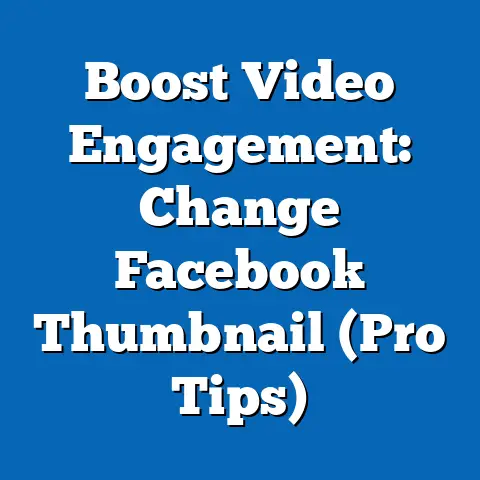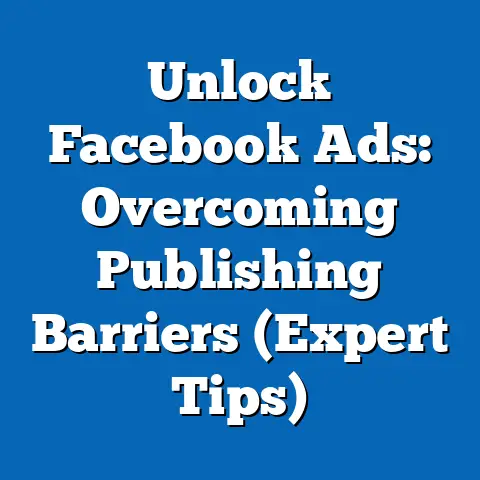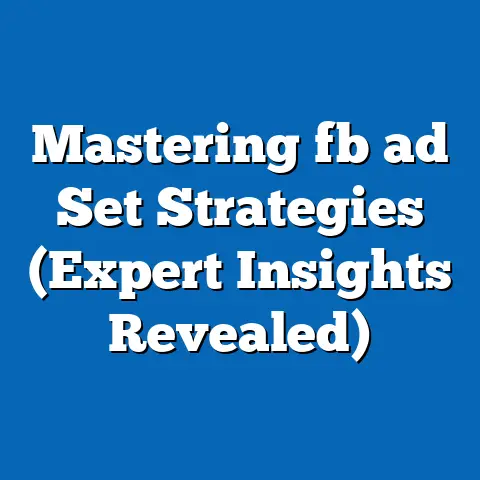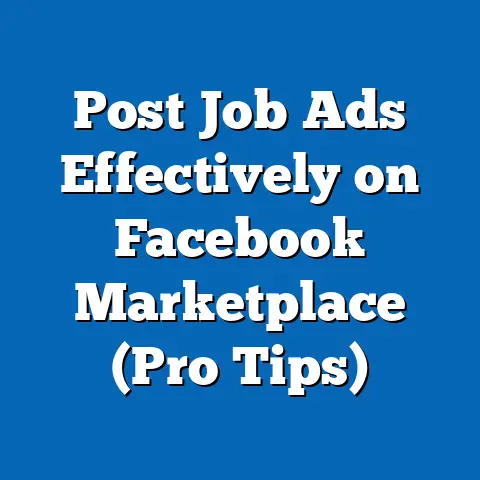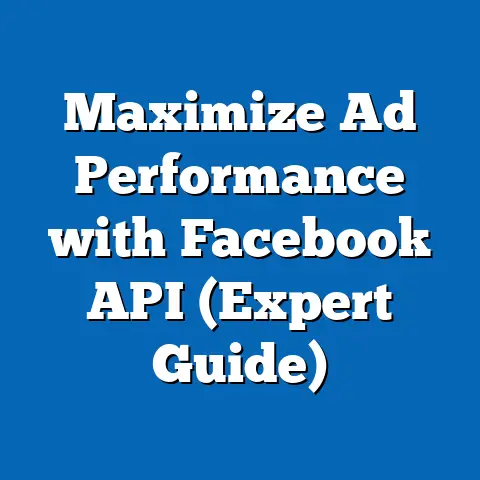Crack the Code to Facebook Ads Success (Proven Strategies)
Imagine a bright summer day. A kid, maybe ten years old, sets up a lemonade stand. The excitement is palpable! They meticulously arrange their cups, ice, and pitchers of homemade lemonade. But there’s a challenge: How do they get people to stop and buy? They learn quickly that a brightly colored sign, a strategic location near the park entrance, and a friendly smile can make all the difference. That’s marketing in its purest form.
Running a Facebook Ad campaign, in many ways, is like that lemonade stand. You’ve got a product (or service), and you need to get it in front of the right people. Just as the kid with the lemonade stand needs to understand their audience – thirsty park-goers on a hot day – you need to understand who you’re trying to reach on Facebook. And just like that kid needs to adapt based on what’s working – raising prices if demand is high, adding a new flavor if customers request it – you need to constantly analyze and optimize your Facebook Ads to get the best results.
I’ve spent years navigating the world of Facebook Ads, and I’ve seen firsthand how powerful they can be. I’ve also seen countless businesses waste money and get frustrated because they didn’t understand the fundamentals. In this guide, I’m going to share proven strategies that will help you crack the code to Facebook Ads success, turning those potential customers into loyal buyers. Let’s dive in!
Understanding Facebook Ads
Facebook Ads are essentially paid messages that businesses use to reach a specific audience on Facebook (and its associated platforms like Instagram). They are a cornerstone of digital marketing for a reason: Facebook boasts billions of active users, offering unparalleled reach and targeting capabilities.
Think of it this way: traditional advertising, like a billboard, broadcasts your message to everyone who drives by. Facebook Ads, on the other hand, allow you to laser-focus your message on people who are most likely to be interested in what you have to offer.
Let’s break down the key components:
-
Ad Formats: Facebook offers a variety of formats, from simple image ads to engaging video ads, dynamic carousels (allowing users to scroll through multiple images or videos), and even lead generation forms. Choosing the right format depends on your objectives and the story you want to tell. I’ve found that video ads often outperform static images, especially for capturing attention in a crowded news feed.
-
Targeting Options: This is where Facebook Ads truly shine. You can target users based on demographics (age, gender, location), interests (hobbies, passions, pages they like), behaviors (purchase history, device usage), and even custom audiences (lists of your existing customers). The more specific you are with your targeting, the more likely you are to reach the right people.
-
Placements: Your ad can appear in various locations across Facebook and Instagram, including the news feed, right column, stories, and even within Messenger. Different placements can have different performance characteristics. For example, ads in Instagram Stories tend to be more visually driven and concise than those in the Facebook news feed.
Ad Formats: Facebook offers a variety of formats, from simple image ads to engaging video ads, dynamic carousels (allowing users to scroll through multiple images or videos), and even lead generation forms. Choosing the right format depends on your objectives and the story you want to tell. I’ve found that video ads often outperform static images, especially for capturing attention in a crowded news feed.
Targeting Options: This is where Facebook Ads truly shine. You can target users based on demographics (age, gender, location), interests (hobbies, passions, pages they like), behaviors (purchase history, device usage), and even custom audiences (lists of your existing customers). The more specific you are with your targeting, the more likely you are to reach the right people.
Placements: Your ad can appear in various locations across Facebook and Instagram, including the news feed, right column, stories, and even within Messenger. Different placements can have different performance characteristics. For example, ads in Instagram Stories tend to be more visually driven and concise than those in the Facebook news feed.
Understanding these components is crucial. Aligning your Facebook Ads with your overall business goals is paramount. Are you trying to generate leads, drive sales, increase brand awareness, or something else? Your objectives will dictate your ad format, targeting, and bidding strategy. Without this alignment, you’re essentially throwing money at the wall and hoping something sticks.
Takeaway: Facebook Ads are a powerful tool, but they require a strategic approach. Understanding the platform’s components and aligning your ads with your business goals are the first steps to success.
Identifying Your Target Audience
Imagine trying to sell snow shovels in Florida. You might sell a few to tourists, but you’re not likely to have much success. Similarly, running a Facebook Ad campaign without a clear understanding of your target audience is a recipe for wasted ad spend.
Audience targeting is arguably the most critical aspect of Facebook Ads. It’s about identifying the specific group of people who are most likely to be interested in your product or service. Facebook offers a wealth of tools and options to help you do this effectively.
Here are some tips for defining and segmenting your target audience:
-
Facebook Audience Insights: This is a powerful tool that provides valuable data about Facebook users, including their demographics, interests, page likes, and purchase behaviors. Use it to explore potential audience segments and refine your targeting. I often use Audience Insights to get a better understanding of the demographics of people who are interested in my client’s services.
-
Customer Personas: Create detailed profiles of your ideal customers. Give them names, ages, occupations, and hobbies. What are their pain points? What are their needs? The more you understand your ideal customer, the better you can tailor your messaging and targeting.
-
Lookalike Audiences: This allows you to create new audiences based on your existing customers. Facebook will identify users who share similar characteristics and behaviors with your customer base, expanding your reach to potential new buyers. I’ve found that lookalike audiences based on high-value customers (those who spend the most) tend to perform the best.
-
Interest-Based Targeting: This allows you to target users based on their stated interests and the pages they like on Facebook. This can be a powerful way to reach people who are passionate about a particular topic or industry.
Facebook Audience Insights: This is a powerful tool that provides valuable data about Facebook users, including their demographics, interests, page likes, and purchase behaviors. Use it to explore potential audience segments and refine your targeting. I often use Audience Insights to get a better understanding of the demographics of people who are interested in my client’s services.
Customer Personas: Create detailed profiles of your ideal customers. Give them names, ages, occupations, and hobbies. What are their pain points? What are their needs? The more you understand your ideal customer, the better you can tailor your messaging and targeting.
Lookalike Audiences: This allows you to create new audiences based on your existing customers. Facebook will identify users who share similar characteristics and behaviors with your customer base, expanding your reach to potential new buyers. I’ve found that lookalike audiences based on high-value customers (those who spend the most) tend to perform the best.
Interest-Based Targeting: This allows you to target users based on their stated interests and the pages they like on Facebook. This can be a powerful way to reach people who are passionate about a particular topic or industry.
Let’s look at an example: A local bakery wants to promote its new line of gluten-free pastries. They could target users in their local area who have expressed an interest in “gluten-free baking,” “healthy eating,” or “local bakeries.” They could also create a lookalike audience based on their existing customers who have purchased gluten-free products in the past.
The key is to be as specific as possible. Don’t just target “everyone” who might be interested in your product. Focus on identifying the specific segments of users who are most likely to convert.
I once worked with a client who was selling high-end baby clothes. Initially, they were targeting all women aged 25-45. By refining their targeting to focus on women who were engaged, pregnant, or had recently given birth, we saw a significant improvement in their ad performance.
Takeaway: Effective audience targeting is the foundation of a successful Facebook Ad campaign. Use Facebook Audience Insights, create customer personas, and leverage lookalike audiences to reach the right people with your message.
Crafting Compelling Ad Copy and Visuals
You’ve identified your target audience, now what? You need to create ads that grab their attention and persuade them to take action. This is where compelling ad copy and visuals come into play.
Your ad copy is your opportunity to communicate your message and entice users to click. Here are some proven strategies:
- Headlines: Your headline is the first thing people will see, so make it count. Use strong verbs, ask a question, or offer a compelling benefit. I find that headlines that include numbers (“5 Ways to…”) or address a specific pain point tend to perform well.
- Body Text: Use clear and concise language to explain your offer and why it’s valuable to the user. Highlight the key benefits and features of your product or service. Focus on what the user will gain by clicking on your ad.
- Call-to-Action (CTA): Tell the user what you want them to do. Use strong CTAs like “Shop Now,” “Learn More,” “Sign Up,” or “Get Started.” Make your CTA clear and prominent.
- Speak to Your Audience: Use language that resonates with your target audience. Understand their needs and pain points, and address them directly in your ad copy.
Visuals are equally important. High-quality images and engaging videos can capture attention and communicate your message more effectively than text alone.
- High-Quality Images: Use professional-looking images that are relevant to your offer. Avoid blurry or low-resolution images.
- Engaging Videos: Videos can be a powerful way to tell your story and showcase your product or service. Keep your videos short and engaging, and make sure they have a clear call-to-action.
- A/B Testing: Don’t be afraid to experiment with different ad copy and visuals. Use A/B testing to compare different versions of your ads and see which ones perform best.
I worked with a client who was selling online courses. Initially, their ads featured generic stock photos and bland ad copy. By replacing the stock photos with images of real students and rewriting the ad copy to focus on the specific benefits of the course, we saw a dramatic increase in their click-through rate and conversion rate.
Remember that Facebook has specific ad specifications for image and video sizes. Make sure you adhere to these guidelines to avoid having your ads rejected or appearing distorted.
Takeaway: Compelling ad copy and visuals are essential for capturing attention and persuading users to click on your ads. Use strong headlines, clear body text, and prominent CTAs. Use high-quality images and engaging videos that are relevant to your offer. And don’t be afraid to A/B test different versions of your ads to see what performs best.
Setting a Budget and Bidding Strategy
You’ve crafted compelling ads and targeted the right audience. Now, it’s time to talk about money. Setting an appropriate budget and choosing the right bidding strategy are crucial for maximizing your return on investment (ROI).
First, let’s talk about budget. How much should you spend on Facebook Ads? The answer depends on your goals, your target audience, and your industry. There’s no one-size-fits-all answer, but here are some general guidelines:
- Start Small: If you’re new to Facebook Ads, start with a small budget and gradually increase it as you see results.
- Consider Your Goals: How many leads or sales do you want to generate? How much are you willing to spend to acquire a new customer?
- Track Your ROI: Monitor your ad performance closely and track your ROI. If you’re not seeing a positive return, adjust your budget accordingly.
Facebook offers two main budget options:
- Daily Budget: This is the average amount you’re willing to spend each day.
- Lifetime Budget: This is the total amount you’re willing to spend over the entire duration of your campaign.
Next, let’s talk about bidding strategies. Facebook offers several different bidding strategies, each designed to optimize for different goals:
- Cost Per Click (CPC): You pay each time someone clicks on your ad. This is a good option if you’re focused on driving traffic to your website.
- Cost Per Impression (CPM): You pay for every 1,000 impressions (the number of times your ad is shown). This is a good option if you’re focused on increasing brand awareness.
- Cost Per Conversion (CPA): You pay each time someone completes a desired action, such as making a purchase or filling out a form. This is a good option if you’re focused on generating leads or sales.
The best bidding strategy depends on your goals and your target audience. If you’re new to Facebook Ads, I recommend starting with CPC bidding and gradually transitioning to CPA bidding as you gather more data.
It’s also important to monitor your spending closely and adjust your bids based on ad performance. If your ads are performing well, you can increase your bids to reach more people. If your ads are not performing well, you can decrease your bids to save money.
I once worked with a client who was using CPM bidding for a lead generation campaign. They were spending a lot of money, but they weren’t generating many leads. By switching to CPA bidding and optimizing their ads for conversions, we were able to significantly reduce their cost per lead.
Takeaway: Setting an appropriate budget and choosing the right bidding strategy are crucial for maximizing your ROI. Start small, consider your goals, track your ROI, and monitor your spending closely. Experiment with different bidding strategies to see what works best for your business.
Analyzing Ad Performance
You’ve launched your Facebook Ad campaign, set your budget, and chosen your bidding strategy. Now, it’s time to track your results and analyze your ad performance.
Facebook Ads Manager provides a wealth of data and metrics to help you understand how your ads are performing. Here are some key performance indicators (KPIs) to track:
- Click-Through Rate (CTR): This is the percentage of people who saw your ad and clicked on it. A high CTR indicates that your ad copy and visuals are resonating with your target audience.
- Conversion Rate: This is the percentage of people who clicked on your ad and completed a desired action, such as making a purchase or filling out a form. A high conversion rate indicates that your landing page is effective at converting traffic into leads or sales.
- Cost Per Click (CPC): This is the average amount you’re paying for each click on your ad. A low CPC indicates that your ads are efficient at driving traffic to your website.
- Cost Per Conversion (CPA): This is the average amount you’re paying for each conversion. A low CPA indicates that your ads are efficient at generating leads or sales.
- Return on Ad Spend (ROAS): This is the amount of revenue you’re generating for every dollar you’re spending on ads. A high ROAS indicates that your ads are profitable.
By tracking these KPIs, you can gain valuable insights into how your ads are performing and identify areas for improvement. For example, if your CTR is low, you may need to revise your ad copy or visuals. If your conversion rate is low, you may need to improve your landing page. If your CPA is high, you may need to adjust your targeting or bidding strategy.
It’s also important to track your ad performance over time. Are your ads performing better or worse than they were last week? Are there any trends or patterns that you can identify? By tracking your ad performance over time, you can identify opportunities to optimize your campaigns and improve your results.
I always advise my clients to set up custom dashboards in Facebook Ads Manager to track the metrics that are most important to their business. This allows them to quickly and easily monitor their ad performance and identify any potential issues.
Takeaway: Analyzing your ad performance is essential for optimizing your campaigns and maximizing your ROI. Track key performance indicators such as CTR, conversion rate, CPC, CPA, and ROAS. Monitor your ad performance over time and identify opportunities for improvement.
Scaling Your Facebook Ads
You’ve created a successful Facebook Ad campaign, analyzed your results, and optimized your performance. Now, it’s time to scale your ads and reach even more people.
Scaling your Facebook Ads involves increasing your budget, expanding your target audience, and diversifying your ad formats. However, it’s important to do this strategically to avoid sacrificing ad relevance and quality.
Here are some strategies for scaling your Facebook Ads:
Scaling your Facebook Ads is not just about spending more money. It’s about finding new ways to reach your target audience and maintain ad relevance and quality.
Takeaway: Scaling your Facebook Ads involves increasing your budget, expanding your target audience, and diversifying your ad formats. Do this strategically to avoid sacrificing ad relevance and quality.
Conclusion
Like that kid with the lemonade stand, success in Facebook Ads isn’t just about setting up shop. It’s about understanding your customers, offering them something valuable, and constantly adapting to their needs. By understanding the fundamentals of Facebook Ads, identifying your target audience, crafting compelling ad copy and visuals, setting a budget and bidding strategy, analyzing your ad performance, and scaling your campaigns, you can crack the code to Facebook Ads success and achieve your business goals.
Don’t be afraid to experiment, test new strategies, and learn from your mistakes. The Facebook Ads platform is constantly evolving, so it’s important to stay up-to-date on the latest trends and best practices. Now go out there and start cracking the code to your own Facebook Ads success story!

